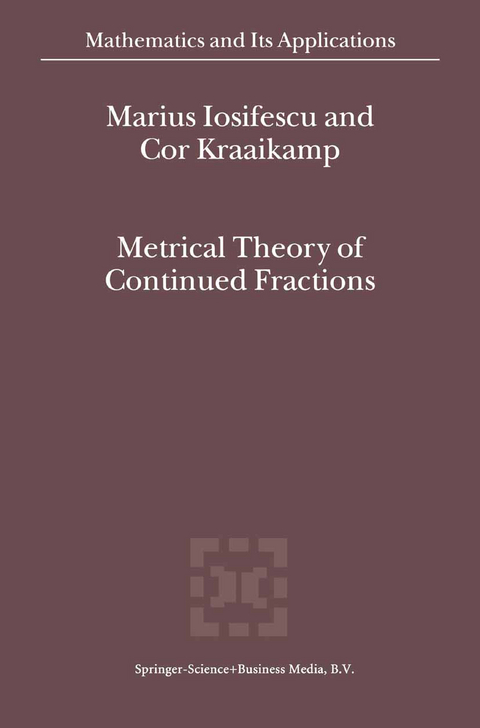
Metrical Theory of Continued Fractions
Seiten
2002
|
2002 ed.
Springer-Verlag New York Inc.
978-1-4020-0892-4 (ISBN)
Springer-Verlag New York Inc.
978-1-4020-0892-4 (ISBN)
The positive integers an(w) = al(T - (W)), n E N+ = {1,2··· }, where al(w) = integer part of 1/w, w E 0, are called the (regular continued fraction) digits of w. n, we have w = lim [al(w),··· , an(w)], w E 0, n--->oo thus explaining the name of T.
This monograph is intended to be a complete treatment of the metrical the ory of the (regular) continued fraction expansion and related representations of real numbers. We have attempted to give the best possible results known so far, with proofs which are the simplest and most direct. The book has had a long gestation period because we first decided to write it in March 1994. This gave us the possibility of essentially improving the initial versions of many parts of it. Even if the two authors are different in style and approach, every effort has been made to hide the differences. Let 0 denote the set of irrationals in I = [0,1]. Define the (reg ular) continued fraction transformation T by T (w) = fractional part of n 1/w, w E O. Write T for the nth iterate of T, n E N = {O, 1, ... }, n 1 with TO = identity map. The positive integers an(w) = al(T - (W)), n E N+ = {1,2··· }, where al(w) = integer part of 1/w, w E 0, are called the (regular continued fraction) digits of w. Writing . for arbitrary indeterminates Xi, 1 :::; i :::; n, we have w = lim [al(w),··· , an(w)], w E 0, n--->oo thus explaining the name of T. The above equation will be also written as w = lim [al(w), a2(w),···], w E O.
This monograph is intended to be a complete treatment of the metrical the ory of the (regular) continued fraction expansion and related representations of real numbers. We have attempted to give the best possible results known so far, with proofs which are the simplest and most direct. The book has had a long gestation period because we first decided to write it in March 1994. This gave us the possibility of essentially improving the initial versions of many parts of it. Even if the two authors are different in style and approach, every effort has been made to hide the differences. Let 0 denote the set of irrationals in I = [0,1]. Define the (reg ular) continued fraction transformation T by T (w) = fractional part of n 1/w, w E O. Write T for the nth iterate of T, n E N = {O, 1, ... }, n 1 with TO = identity map. The positive integers an(w) = al(T - (W)), n E N+ = {1,2··· }, where al(w) = integer part of 1/w, w E 0, are called the (regular continued fraction) digits of w. Writing . for arbitrary indeterminates Xi, 1 :::; i :::; n, we have w = lim [al(w),··· , an(w)], w E 0, n--->oo thus explaining the name of T. The above equation will be also written as w = lim [al(w), a2(w),···], w E O.
1 Basic properties of the continued fraction expansion.- 2 Solving Gauss’ problem.- 3 Limit theorems.- 4 Ergodic theory of continued fractions.- Appendix 1: Spaces, functions, and measures.- A1.1.- A1.2.- A1.3.- A1.4.- A1.5.- A1.6.- Appendix 2: Regularly varying functions.- A2.1.- A2.2.- A2.3.- Appendix 3: Limit theorems for mixing random variables.- A3.1.- A3.2.- A3.3.- Notes and Comments.- References.
| Erscheint lt. Verlag | 30.9.2002 |
|---|---|
| Reihe/Serie | Mathematics and Its Applications ; 547 | Mathematics and Its Applications ; 547 |
| Zusatzinfo | XIX, 383 p. |
| Verlagsort | New York, NY |
| Sprache | englisch |
| Maße | 156 x 234 mm |
| Themenwelt | Mathematik / Informatik ► Mathematik ► Wahrscheinlichkeit / Kombinatorik |
| ISBN-10 | 1-4020-0892-9 / 1402008929 |
| ISBN-13 | 978-1-4020-0892-4 / 9781402008924 |
| Zustand | Neuware |
| Haben Sie eine Frage zum Produkt? |
Mehr entdecken
aus dem Bereich
aus dem Bereich
Buch | Softcover (2024)
Springer Spektrum (Verlag)
CHF 62,95
Eine Einführung in die faszinierende Welt des Zufalls
Buch | Softcover (2024)
Springer Spektrum (Verlag)
CHF 55,95


